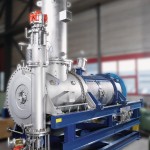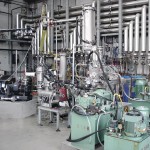The use of large amounts of solvent in polymerisation processes, with all their concomitant disadvantages, is no longer necessary. An optimised method allows solvents to be degassed directly without having to resort to stripping additives. Separation steps are avoided and new product qualities achieved.
Solution polymerisation processes are used today for the production of various polymers on an industrial scale, especially when heat removal during bulk polymerisation, in other words without the use of solvents, would not be sufficient or if the end product is a polymer solution. The solvents chosen for this purpose are usually organic, e.g. toluene, hexane or cyclo- hexane, in which both the monomers and the reacted polymer are dissolved in the course of polymerisation. The manufacture of thermoplastic resins, rubbers or thermoplastic elastomer bales is energy-intensive and demands complicated equipment in order to separate the solvent from the polymer as the end product. The permissible residual solvent or residual monomer content depends on the user’s requirements and on where the polymers will be utilised; it is typically well below 3000 ppm or in some cases as little as 500 ppm. The crucial process step, apart from the polymerisation itself, is therefore the separation of the solvent from the polymer solution. This step is commonly referred to as de-volatilisation because it exploits the higher volatility of the solvents and the residual monomers compared to pure polymer as the separation principle. Steam stripping is currently the most popular method for removing residual solvents and monomers: the polymer solution is heated using superheated steam while the solvent is separated. The steam thus provides the enthalpy that is essential to evaporate the solvent. The water also neutralises the existing catalyst residues, particularly from Ziegler-Natta catalysts, and removes them from the polymer. In practice, this process necessitates a considerable quantity of energy, resulting in a steam surplus. The accumulated amount of water / solvent vapour mixture must be liquefied and separated in the downstream condenser. Extensive and complex equipment is required to process the liquefied water/solvent mixture.
The development of new catalysts combined with the additional market requirements for special polymer grades, the need to conserve energy and resources and the reduction in the amount of equipment have led to a reappraisal of the basic process design. The trend is now away from conventional technology featuring steam stripping and towards more advanced alternatives that avoid the excessive use of solvents, provide increased energy efficiency and cut down the need for process equipment. This novel approach will open up new opportunities for manufacturers of special temperature-sensitive and thermally stable thermoplastics, rubbers and other elastomers.
Direct energy input by kneading
This paradigm shift calls for a complete rethink of the polymerisation process and the subsequent integration of the monomer/solvent separation step. The carrier medium for the flow of energy is no longer the steam but the mechanical energy dissipated by the moving kneading shaft that is absorbed into the polymer; the heat transport through wall contact is only a secondary aspect. This innovative principle is ideal for polymer processes with metal- locene catalysts, because their residues are allowed to remain in the polymer product. The fact that large vapour flows are avoided – referred to at List as “dry processing” – holds enormous potential for a variety of polymers, such as BR, SBR, EPDM or SBM.
The realisation of this idea is based on a two-step process comprised of continuously operating main evaporation and downstream devolatilisation. The process conditions (mechanical power input, heating temperatures, operating pressures, etc.) can be adjusted individually to ensure efficient and gentle product treatment. Before this process technology can be combined with existing or new polymer products, the process is first trained and optimised at List on its own pilot plant, then verified if necessary on an external, semi-industrial plant at Fraunhofer-Gesellschaft. Special apparatus with an optimised kneader shaft configuration and a robust mechanical design are required to process highly viscous polymer melts, because shaft torques to several hundred thousand Nm often have to be coped with in continuous duty. Whereas the design of the main evaporation step is limited by the flow of energy to evaporate the residual solvent and the residual monomers, the devolatilisation step is characterised by diffusion. The results of the trials show that equivalent or superior product quality can be achieved with lower energy consumption. The overall benefit of this process derives from a combination of several factors, for instance investment requirements, energy use, flexibility, environmental performance, the avoidance of large solvent flows, etc. Based on the KneaderReactor technology, List offers a complete solution package supported by verified scale-up calculations and process simulations, including feed and discharge systems, condensation and vacuum systems, a heating system, product transfer and subsequent polymer treatment, polymer melt filters and pelleti-sing. The functionality and specification of the individual components are harmonised and optimised. Compared to conventional separation of the solvent from elastomer solutions, several process steps are eliminated. The separation of the catalyst using a centrifuge is avoided, for example, and no water or steam is introduced in stirred tanks. The two-stage KneaderReactor technology replaces the entire processing chain including the in extruders (expeller-expanders) currently used for the final processing step. This proven and mature dry finishing technology represents far more than the integration of one component into an existing plant – instead, it is a step into a totally new world with a variety of novel applications for polymer manufacturing and processing.
Online-Info www.cpp-net.com/2310416
Share:








